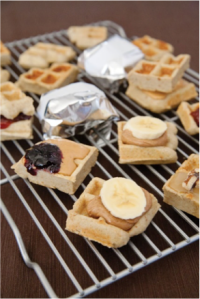by Patricia Schwager
Eat a meal 2.5 to 3 hours pre-race. This is your last chance to fuel your body for the race. Aim for easy to digest carbohydrates and small amounts of fat and protein. This meal can be pretty big. So if racing in the AM, eat a good size breakfast. If racing in the PM, eat an early lunch. Before a TT you may want to have some more time to digest; eat 3.5-4 hours before your TT start time. Keep hydrating during the time till your race starts.
Have a small snack around the time you are warming up. If your race is short (1 hour) take 1 bottle and 1 gel with you.
If you are racing longer than 1 hour, drink at least 1 bottle per hour. Make sure that 1 or better both of your bottles contain some kind of a drink mix. Drinking plain water only doesn’t help you to replace the minerals you are sweating out. Eat something every 30min (gel, 1/2 bar, banana etc.)
It is easy to forget to eat and drink during a race. In cold conditions for example, you might feel less thirsty. Or maybe you are just too scared to take your hands off your handle bar to grab a bottle or a bar. Yep I admit, I made that mistake quite a few times while racing the spring classic races in northern Europe. Instead of eating and drinking enough during the race, I decided to rather keep my hands on my handlebar and not lose any positions in the bunch- it was a bad idea of course.
Remember to eat and drink during a race, the longer the race the more important it is. Try to eat/ drink small amounts but repeat every 15min or so instead of eating a whole bar in once and then nothing for the next hour.
Make use of calm moments or good places in a race to eat and drink. Don’t choose to eat your energy bar right before you head into the next climb.
Very important is also to test a new product at first in training before you use it in a race. Try to find out what works best for you. Not everyone is the same- make sure your nutrition and hydration is dialed in before you use it in racing.
Getting tired of the sweetness or always same flavors of your bars and gels? Try a savory version instead. (Personally I really like a salty nuts bar for a change.)

Sometimes the easy things can be better for you. Instead of always buying expensive bars, gels or drops you could make your own additional race food, just so you have something different in your pockets.
Here are some ideas to make your own race food, it is very easy! Buy waffles, cut them in smaller pieces, putting two together like a sandwich and fill them with jam, vanilla cream, Nutella, peanut or almond butter, etc. Wrap them with foil and they are ready to go in your pocket. Buy some milk breads (small soft breads). Cut them in half and take out some of the soft middle part. Fill in sweets like jam, banana& honey, almond butter etc. or go savory and stuff them with ham or cheese. In the end you put the top back into the bread to close it and ensure the filling stays inside. Again wrap up in foil. These “panini” are a typical Italian style race food.
Other foods that are great to put in your pockets are: coconut macaroons, stroop waffels (the originals are from the Netherlands), dried fruits, bananas, self-made rice cakes etc.
Some more tips:
- Take a scissors/knife and cut your bars in half. You will have less problems with unwrapping them during the race and that way they are already in a good size/serving to eat in once.
- If you need to eat during a race but you know it will be hard to do so, then prepare your bottle before the start with pouring a gel into your bottle. That way you get your energy in without messing around with opening that gel. Typical race to use that tip would be a criterium.
- Don’t throw the empty gel/bar wrapping just out into the nature, put the trash back in your jersey pocket and throw it out in the feeding zone (usually race organizers take care about trash in feeding zones) or then keep it in your pocket till the finish.
- Don’t forget that your nutrition is also important once the race is over! After your cool down keep drinking and within 25 minutes eat and/or drink something easily digestible with simple carbohydrates and a little protein –more protein and less carbohydrate if you are a woman.
- Eat a normal meal 2 hours post-race. Balance the calories you expended during the day of racing with the calories consumed the rest of the day. The right nutrition will help you recover from the race and feel better tomorrow.
ABOUT PATRICIA SCHWAGER
Patricia Schwager began cycling in 1998, racing as a junior. After racing on the domestic level and completing her Diploma as Pastry Chef, she got her first pro contract in 2006. 2015 will be here 10th year of professional racing. Patricia has a lot of experience racing in the European peloton. In 2013 she started working with Shawn Heidgen (Current ALP Cycles Coach) as her personal coach. In 2014 she changed her focus to racing in the US. Patricia is a 6 time national Swiss champion and has represented her home country, Switzerland, at the World Championships 12 times.
]]>








